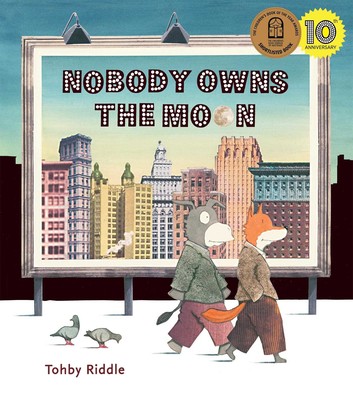‘Nobody Owns the Moon’ is often described as a ‘classic’ tale. A 10th anniversary edition appeared in 2019 again sharing this universal story of friendship, belonging, differences, and life in the city. Our two main characters, a fox and a donkey, live in a city with humans. The endpapers feature solemn, noncommunicating individuals ushering readers into a world that appears isolated, perhaps uncaring. Clive Prendergast, the fox, lives in a city apartment. He just tries to fit in. He works in a factory and his job is to fit two objects together. His friend Humphrey is a donkey with no fixed address. Humphrey struggles to find work and food to eat.
One day, Clive notices a blue envelope amongst Humphrey’s bag of collectables from the street—two tickets to a theatre performance that night. The two go and find themselves treated to delicious hors d’oeuvres, seated in the luxurious dress circle, provided a moving performance and delectable food afterwards. Humphrey is moved to tears, and so too will be readers.
The deeper meaning of this story takes time to internalise, especially for younger readers. The title, ‘Nobody Owns the Moon,’ is a clue. Young readers may ponder why Humphrey and Clive are the only animal characters among the city’s throng of human inhabitants. Why does no one notice? Possible discussions might centre around those less fortunate and society’s responsibilities. As an aside, Adults may lead young viewers to identify the well-known artworks and architecture on the walls. What do they convey?
A close inspection of Riddle’s artwork reveals an interesting use of collage and mixed media which keeps the viewer at arm’s length—observing, wondering. Riddle explains: ‘My general approach to illustration techniques is that anything goes – the only rule being so long as it works. I applied this especially to the artwork in my picture book ‘Nobody Owns the Moon,’ which employed a wide-ranging jumble of media and collage. I hoped this would convey something of the actual mixed-media nature of cities themselves, with their glass, concrete, timber, steel, paper, asphalt, paint, etc.’ (from Books Illustrated Resource)
Tohby Riddle’s work has been translated and nominated/won several awards. Internationally, he is Australia’s nominee for the Hans Christian Andersen Award for 2022.

